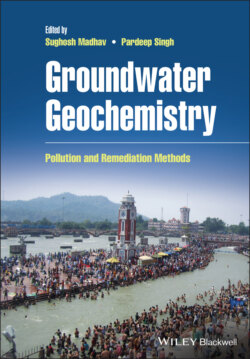Читать книгу Groundwater Geochemistry - Группа авторов - Страница 40
2.1 Introduction
ОглавлениеGroundwater is the major source for drinking and irrigation purposes in Asian countries like Nepal, Bangladesh, China, India, and Pakistan (Al‐Hatim et al. 2015; Raj and Shaji 2017). Annual consumption of groundwater by these countries is around 300 km3, equivalent to 50% of the total consumption of the world (Shah et al. 2003). Asian countries have a population size of 4.5 billion which constitutes more than half of the total human population of world (WPR 2018). Thus, the large population size and overexploitation of water results in enhanced requirement, as well as demand of groundwater for the purpose of irrigation and drinking that ultimately results in reduction of the level of groundwater in Asia (Gleeson et al. 2012; Gupta et al. 2013; Alhababy and Al 2015). Irrigation utilizes around 85% of Asia's groundwater and is considered to be the main reason behind groundwater depletion (FAO 2013). This groundwater contains various geochemical components such as iron, fluoride, arsenic concentration, etc., which may lead to some serious health ailments. Presence of fluoride anion at higher concentrations, i.e. more than 1.5 mg/L in drinking water, might result in dental and skeletal fluorosis (Vithanage and Bhattacharya 2015). However, at lower concentration, F− in drinking water is proven to be beneficial for consumers as it reduces dental cavities (Guissouma et al. 2017; Raj and Shaji 2017; Yadav et al. 2015). The consumption of fluoride‐contaminated groundwater leads to endemic fluorosis, which causes dangerous health issues among a large percentage of population in India and thus becomes a very challenging and extensively studied national health problem (Rudra 2012).
Fluoride is one of the extensively present contaminants dispersed either through natural or artificial means. Naturally, fluoride contamination occurs due to its dissolution from rocks and soils into the groundwater (Podgorski et al. 2018; Barathi et al. 2019). Anthropogenic activities like industrial effluents released from aluminum and steel industries, glass and semiconductor manufacturing industries, fertilizer, and electroplating industries also lead to fluoride contamination in groundwater (Bhatnagar et al. 2011). Some other sources, like wastewater released from electronics, toothpaste, and insecticide manufacturing industries also result in enhanced levels of fluoride in groundwater (Jagtap et al. 2012).
The fluoride ion occurs naturally in groundwater, however numerous anthropogenic activities like fluorinated industrial waste (glass, aluminum, iron, steel), and also agricultural activities like application of fertilizers (phosphate, potassium), pesticides, etc. increase its concentration in the environment and cause detrimental effects (Gupta et al. 2015, 2019; Srivastav et al. 2018; Maurya et al. 2019). The fluoride concentration varies from region to region daily. The population consuming a dietary habit of fish and tea are much more prone to fluoride, because fluoride is present in higher concentration in them (Kanduti et al. 2016). The problem of fluoride contaminants has become a worldwide problem in groundwater because it is natural as well as uncontrollable (Brunt et al. 2004). According to reports, the geogenic sources are the main cause for exposure of fluoride and its adverse effect increases from consuming fluoride‐polluted groundwater (Sharma et al. 2015; Mukherjee and Singh 2018). The threatening concentration of fluoride ions present in groundwater is higher in different countries in South and Southeastern Asia, in addition to other toxic and infectious substances (WHO 2000).
The southern part of Asia is represented by South Asia, including countries like Bhutan, Bangladesh, Afghanistan, Maldives, India, Nepal, Sri Lanka, and Pakistan. These countries inhabit around 39.5% of the Asian population and also constitute 24% of the world's population (Sikdar 2019). A higher concentration of fluoride in the groundwater of countries like China, India, and Pakistan put a large population's health under risk. The problem of skeletal fluorosis in adults and children occurs due to consumption of groundwater containing high fluoride concentration (3 mg/L). Endemism of fluorosis is found in at least 25 countries of all continents including North America, South America, Europe, Africa, and Asia (Fawell et al. 2006). The large intake of fluoride causes numerous health issues like anorexia, muscle weakness, sweating, dyspnea, severe gastroenteritis, salivation, restlessness, etc. (Sahu et al. 2017). Many chemical factors like dissolution, weathering, ion exchange, precipitation, and several biological processes occurring under the Earth's surface influence the concentration of fluoride in groundwater. Since only a limited number of studies have been done on fluoride impact on human health, and considering its detrimental effects, human health issues were investigated in Iran, mainly in the Sistan and Baluchestan provinces.
Numerous problems ought to be considered while assessing fluoride contamination and its effects:
1 A higher concentration of fluoride in groundwater is limited to arid and semiarid regions of North Africa and Asia.
2 Rocks and sediments having fluorine‐containing minerals are the main source of fluoride for geogenic origin, whereas pesticide and industrial wastes contribute to anthropogenic sources of fluoride.
3 The fluoride ion in water binds with different ions such as chlorides and bicarbonates (Kanchan et al. 2015; Ali et al. 2016). Various studies have been done on defluoridation, although no proper solution to this problem could be found.
